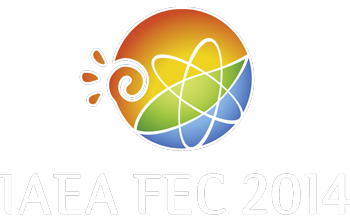Speaker
Dr
Linda Sugiyama
(Massachusetts Institute of Technology)
Description
Instabilities with poloidal and toroidal mode numbers m/n=1/1 remain an important concern for fusion in toroidal plasmas. Sawtooth crashes can periodically reduce the central plasma pressure and fusion rate or trigger more dangerous instabilities. Recent experimental results[1-3] have identified new types of 1/1 modes around and inside the q=1 magnetic surface. Nonlinear full MHD numerical simulations with M3D and their analysis[1,2,4,5] demonstrate that these modes are dynamic and strongly influenced by toroidal and nonlinear mode coupling, effects that have been ignored in most nonlinear theories. As in experiment, multiple 1/1 structures can appear simultaneously around and inside q=1. They include long-lived 1/1 helical density concentrations or ``snakes'' and a variety of internal kink like modes. Background plasma toroidal rotation is important; 1/1 modes tend to rotate coherently with the plasma. Some snakes, such as those due to heavy impurity ions, can form around q=1 without a magnetic island. The states tend to minimize the free energy, since the 1/1 helical temperature develops opposite sign to the helical density, reducing the non-axisymmetric pressure. Snakes can coexist with and partially stabilize periodic sawtooth crashes inside q<1.
At low resistivity, the 1/1 resistive internal kink and sawtooth crash are shaped by terms in the momentum balance that are higher order in inverse aspect ratio, even at small r_1/R_o=1/10. The narrow Sweet-arker-like reconnection layer of reduced MHD rarely develops. Instead, a fast crash phase driven by toroidal nonlinearity, enhanced by these terms, matches experimental crash times and the observed temperature redistribution. The crash does not follow the Kadomtsev sawtooth model because the density is not tightly tied to the magnetic field lines. The higher order terms and mode coupling can affect other instabilities, such as m>1 magnetic islands and plasma edge instabilities.
Work supported by the US DOE Office of Fusion Energy Sciences and SciDAC programs.
[1] L. Delgado-Aparicio, L. Sugiyama, et al., Phys. Rev. Letters 110, (2013) 65006.
[2] L. Delgado-Aparicio, L. Sugiyama, et al., Nucl. Fusion 53, (2013) 043019.
[3] L. Delgado-Aparicio, et al., submitted to Phys. Rev. Letters (2014).
[4] L.E. Sugiyama, Phys. Plasmas 20, 032504 (2013).
[5] L.E. Sugiyama, Phys. Plasmas, to appear (2014).
| Country or International Organisation | USA |
|---|---|
| Paper Number | TH/P1-13 |
Author
Dr
Linda Sugiyama
(Massachusetts Institute of Technology)
Co-author
Dr
Luis F. Delgado-Aparicio
(Princeton Plasma Physics Laboratory)

